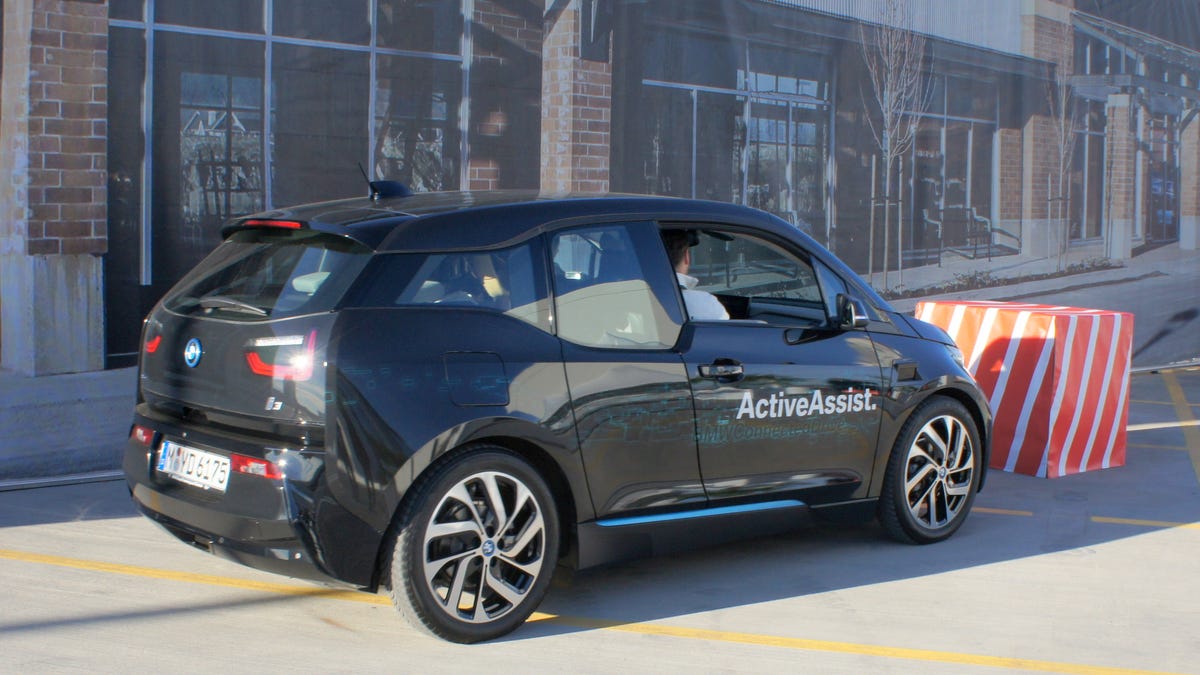I tried, and failed, to crash a BMW i3 at CES 2015
During a demonstration of BMW's ActiveAssist technology in an i3 electric car, I aimed it at a fake brick wall and floored the accelerator, only to have the car hit the brakes.

LAS VEGAS -- On the top level of a parking garage during CES 2015, BMW invited me to take the wheel of its i3 electric car, modified with its experimental ActiveAssist technology. Through a narrow course of soft barriers I followed a BMW minder's instructions and purposefully steered into the obstacles.
For the first one, I let the car roll of its own accord, only to feel the brakes bring it to a stop inches away from the barrier. Getting bolder, I floored it, letting off the accelerator just before the collision. The i3 brought itself smoothly to a stop, again just inches from the barrier. Finally, I just held down the accelerator and shot towards a barrier, but the car overrode my input, preventing a collision.
This i3 saw the world around it using four laser scanners. Two of them, visibly embedded in the front fenders offered a 140-degree field of view each, with the others giving the car a 360-degree picture of its environment. The input from these sensors was wired into the i3's brain, which used an algorithm telling it when to hit the brakes. This active collision avoidance system is one of BMW's stepping stones to the completely autonomous car.
BMW's Dr. Monte Werling told me that the lasers have a few blind spots close into the car, but the ActiveAssist processing can extrapolate the location of objects it had in its view. With this implementation, Werling said the i3 could effectively prevent collisions at speeds up to 15 mph. The thinking behind this concept system seemed to focus on preventing scratches or dents to the vehicle from city and parking lot collisions, rather than safety in high-speed collisions, keeping a future BMW model looking as fresh as the day it was new.
Automatic valet
Just as interesting as not crashing an i3, BMW used the same ActiveAssist technology to power an automated valet system. For this demonstration, BMW automated-driving expert Georg Tanzmeizer used a Samsung smartwatch to send the i3 to find a parking space, and then have it return.
The watch was loaded with a BMW app that let it connect to the car over the Internet, the i3 having its own Internet connection. Standing out on the parking deck, Tanzmeizer pushed a button on the watch and the i3 took off on its own. With no driver, it headed down a line of cars until it identified a parking spot.
And rather than nosing into the perpendicular spot, it took the more difficult option of backing in.
After it had finished, Tanzmeizer said, "BMW pick me up," to the watch, and I could see in the distance the car pulling out of the space, then heading our way.
This car used the exact same laser sensors as the collision-avoiding ones, but calculated a path through the parking area with the sensor data. Tanzmeizer pointed out that as it calculated the path dynamically, each time he sent it to park it might take a slightly different path.
Rather than come to the GPS coordinates of the watch, however, the return trip of the car ended at a preset valet zone. BMW expects that a parking garage would designate such a zone for cars with this type of automation. You could start walking toward the garage valet zone from a restaurant or other urban location, tell your car to pick you up, and it would be waiting for you, ready to get back on the road.
All of this technology shows good promise, but Werling told me it is still a few years out. The cost of the laser scanners in particular will need to come down to make this system practical for production cars.

